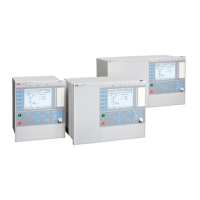Activation of the different zones verifies that the CS signal is issued from the intended
zones. The CS signal from the independent tripping zone must have a tSendMin minimum
time.
Check the tripping function by activating the CR and CR_GUARD inputs with the
overreaching zone used to achieve the PLTR_CRD signal.
It is sufficient to activate the zones with only one type of fault with the secondary injection.
11.11.1.1 Testing permissive underreaching
1. Activate the receive (CR) signal in the IED.
2. Apply healthy normal load conditions to the IED for at least two seconds.
3. Apply a fault condition within the permissive zone.
4. Check that correct trip outputs, external signals, and indications are obtained for the
actual type of fault generated.
5. Check that other zones operate according to their zone timers and that the send (CS)
signal is obtained only for the zone configured to generate the actual signal.
6. Deactivate the receive (CR) signal in the IED.
7. Check that the trip time complies with the zone timers and that correct trip outputs,
external signals, and indications are obtained for the actual type of fault generated.
11.11.1.2 Testing permissive overreaching
1. Activate the receive (CR) signal in the IED.
2. Apply healthy normal load conditions to the IED for at least two seconds.
3. Apply a fault condition within the permissive zone.
4. Check that correct trip outputs, external signals, and indication are obtained for the
actual type of fault generated.
5. Check that the other zones operate according to their zone timer and that the send
(CS) signal is obtained only for the zones that are configured to give the actual
signal. Also the zone connected to CS underreach is giving CS in this mode.
6. Deactivate the IED receive (CR) signal.
7. Apply healthy normal load conditions to the IED for at least two seconds.
8. Apply a fault condition within the permissive zone.
9. Check that trip time complies with the zone timers and that correct trip outputs,
external signals, and indications are obtained for the actual type of fault generated.
11.11.1.3 Testing blocking scheme
1MRK 504 165-UUS - Section 11
Testing functionality by secondary injection
Transformer protection RET670 2.2 ANSI 259
Commissioning manual

